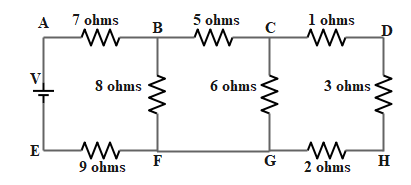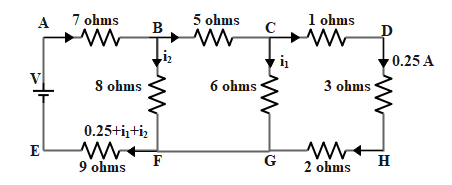
In the ladder network shown, current through the 3 ohms resistor is 0.25 A. The input voltage V is equal to

A. 1 V
B. 20 V
C. 5 V
D.5/2 V

Answer
555.9k+ views
Hint: In this question we have been asked to calculate the input voltage of the given circuit. We have been given a circuit diagram that consists of various resistors connected in series and parallel combinations. These resistors and battery form three different loops as shown in the figure. Therefore, to calculate the value of input voltage of the given circuit, we shall use Kirchhoff's loop rule for voltage or Kirchhoff’s voltage rule which states that in a loop of a circuit the sum of the voltage across the elements is zero.
Complete answer:
It is given that the current through the 3ohm resistor is 25 A.
Now, from the figure below,

Applying the Kirchhoff’s loop rule to the loop CDGH, considering the direction of flow of current as positive
We get,
\[0.25\times 3+0.25\times 2-{{i}_{1}}\times 6=0\]
On solving,
\[1.5=6{{i}_{1}}\]
Therefore,
\[{{i}_{1}}=0.25\] ……………. (1)
Now, consider the loop BCGF
From Kirchhoff’s rule
We get,
\[5\left( 02.5+{{i}_{1}} \right)+6{{i}_{1}}-8{{i}_{2}}=0\]
Therefore,
\[{{i}_{2}}=0.5\] ………………… (2)
Now applying the Kirchhoff’s rule for the last loop with the battery
We get,
\[7\left( 0.25+{{i}_{1}}+{{i}_{2}} \right)+8{{i}_{2}}+9\left( 0.25+{{i}_{1}}+{{i}_{2}} \right)=V\]
After substituting the values from (1) and (2) in above equation
We get,
\[V=7+4+9\]
Therefore,
\[V=20V\]
Therefore, the correct answer is option B.
Note:
The Kirchhoff’s law states that the algebraic sum of potential differences in any loop of a circuit must be equal to zero. While using the Kirchhoff’s the direction to go around the loop must be selected. It is very important to select a direction. If the value of the direction comes to be negative then the original direction of current flow is in the opposite direction.
Complete answer:
It is given that the current through the 3ohm resistor is 25 A.
Now, from the figure below,

Applying the Kirchhoff’s loop rule to the loop CDGH, considering the direction of flow of current as positive
We get,
\[0.25\times 3+0.25\times 2-{{i}_{1}}\times 6=0\]
On solving,
\[1.5=6{{i}_{1}}\]
Therefore,
\[{{i}_{1}}=0.25\] ……………. (1)
Now, consider the loop BCGF
From Kirchhoff’s rule
We get,
\[5\left( 02.5+{{i}_{1}} \right)+6{{i}_{1}}-8{{i}_{2}}=0\]
Therefore,
\[{{i}_{2}}=0.5\] ………………… (2)
Now applying the Kirchhoff’s rule for the last loop with the battery
We get,
\[7\left( 0.25+{{i}_{1}}+{{i}_{2}} \right)+8{{i}_{2}}+9\left( 0.25+{{i}_{1}}+{{i}_{2}} \right)=V\]
After substituting the values from (1) and (2) in above equation
We get,
\[V=7+4+9\]
Therefore,
\[V=20V\]
Therefore, the correct answer is option B.
Note:
The Kirchhoff’s law states that the algebraic sum of potential differences in any loop of a circuit must be equal to zero. While using the Kirchhoff’s the direction to go around the loop must be selected. It is very important to select a direction. If the value of the direction comes to be negative then the original direction of current flow is in the opposite direction.
Recently Updated Pages
Derive the relation between torque and moment of i class 11 physics CBSE

Differentiate between an ionic bond and a covalent class 11 chemistry CBSE

What is the difference between noise and music Can class 11 physics CBSE

Discuss the variation of acceleration due to gravity class 11 physics CBSE

How many ATP molecules are produced in the Krebs cycle class 11 biology CBSE

What is the specific heat capacity of ice water and class 11 physics CBSE

Trending doubts
10 examples of friction in our daily life

One Metric ton is equal to kg A 10000 B 1000 C 100 class 11 physics CBSE

Difference Between Prokaryotic Cells and Eukaryotic Cells

1 Quintal is equal to a 110 kg b 10 kg c 100kg d 1000 class 11 physics CBSE

State the laws of reflection of light

Explain zero factorial class 11 maths CBSE




